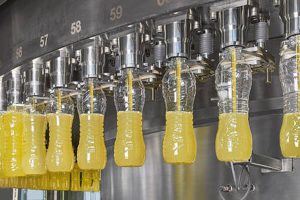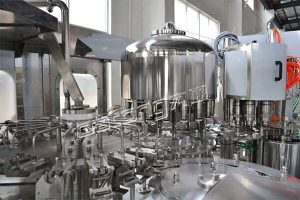When it comes to packaging liquid products, selecting the right liquid filling machine is crucial. With a wide range of filling machines available, each designed to handle specific types of liquids and containers, making the right choice can significantly impact your production efficiency and product quality. Whether you’re filling thin liquids or thick pastes, understanding the different types of liquid filling machines and their applications will help you make an informed decision.
How to Choose the Right Liquid Filling Machine
Selecting the best liquid filling machine for your business depends on several factors. These include the viscosity of the liquid, the type of container, the required fill volume, and the desired production speed. Let’s take a look at these key considerations and explore the different types of liquid filling machines available on the market.
Liquid Viscosity
The viscosity of the liquid you’re filling is one of the most important factors to consider. Liquids can vary from water-thin to highly viscous pastes, and different filling machines are better suited for different viscosities. For example, if you are filling thick sauces or creams, you’ll need a piston or pump filler that can handle high viscosity liquids. For thinner liquids like water or juices, gravity or overflow fillers might be more suitable.

Container Type
Another key consideration is the type of container you are using. Different filling machines are designed to handle different container shapes and sizes. Whether your containers are glass, plastic, or metal, and whether they are small bottles or large jugs, selecting a machine that fits your container type is crucial for efficient filling and minimal product waste.
Fill Volume and Accuracy
Fill volume and accuracy are critical, especially if your industry requires precise measurements. Some industries have strict regulations regarding fill volumes, and selecting the right machine ensures you meet those standards. Net weight fillers are an excellent option for businesses that require precise control over the fill weight, while overflow fillers are ideal for maintaining consistent fill levels in bottles.
Production Speed
The speed at which your machine can fill containers is another important factor to consider. If you have a high-volume production line, you’ll need a machine that can handle large quantities in a short amount of time. Fully automatic systems like inline fillers and monobloc filling systems are best for high-speed operations, while semi-automatic machines are more suited for lower-volume or custom filling needs.
Types of Liquid Filling Machines
Now that we’ve covered the key considerations, let’s dive into the various types of liquid filling machines, each designed for different applications and requirements.
Atmospheric Pressure Fillers
Atmospheric Pressure Fillers rely on the force of gravity to fill containers and are ideal for low-viscosity liquids such as water, juices, or other non-carbonated beverages. This filling machine uses the natural pressure of the atmosphere to push liquid into containers. It’s a simple, cost-effective solution that provides ease of operation, but it’s most suitable for liquids that flow easily and do not require precision under pressure. The simplicity and lower cost make these fillers a great option for smaller production lines or products that do not require precise volume control.

Pressure Fillers
Pressure Fillers are designed for thicker liquids or products that require more precise control over the filling process. These machines use pressure to push liquid into containers, making them perfect for liquids with higher viscosity, such as sauces, oils, lotions, and creams. By pressurizing the liquid reservoir, the liquid is forced into containers under controlled conditions, ensuring consistent fill volumes. This makes pressure fillers ideal for industries where both speed and accuracy are essential, such as in cosmetics, pharmaceuticals, and food products.
Vacuum Fillers
Vacuum Fillers are ideal for products that require protection from air exposure or foam formation. These fillers operate under a vacuum environment, drawing liquid into the containers without causing air bubbles or foam. They are perfect for delicate or viscous liquids, such as syrups, creams, and some beverages, where preserving the liquid’s integrity is critical. Vacuum fillers are often used in the pharmaceutical industry and high-end food packaging, where the goal is to prevent contamination and ensure a precise, clean fill. The process of vacuum filling helps to protect sensitive products, making them an excellent choice for premium and delicate items.
Gravity Fillers
Gravity fillers are best suited for thin, free-flowing liquids. These machines use gravity to fill containers, making them ideal for products like water, beverages, and household cleaners. They are simple, cost-effective, and easy to maintain. However, they are not suitable for thick or foamy liquids.
Piston Fillers
Piston fillers are versatile machines that can handle liquids of various viscosities. They work by drawing the liquid into a cylinder and then forcing it into containers using a piston. These machines are ideal for filling thick liquids like sauces, creams, and pastes. They provide precise fill volumes, making them popular in industries where accuracy is important.
Pump Fillers
Pump fillers are highly versatile and can be used for liquids with low to high viscosities. These machines use pumps, such as peristaltic or rotary pumps, to transfer the liquid into containers. They are suitable for a wide range of products, including lotions, syrups, and automotive fluids. Pump fillers can be automated for higher production rates, making them a great choice for businesses looking to scale up.
Overflow Fillers
Overflow fillers are designed to fill containers to a consistent level. They are ideal for products like sauces, condiments, and beverages, where maintaining a uniform fill height is important. These machines use diving nozzles that create a seal around the bottle neck, ensuring that any excess liquid overflows back into the reservoir, preventing spills and waste.
Net Weight Fillers
Net weight fillers are specifically designed for high-accuracy filling by weight rather than volume. These machines are equipped with a scale that ensures each container is filled with the exact weight of liquid required. They are perfect for industries where precise weight control is crucial, such as in the filling of pharmaceuticals or high-value liquids.
Choosing the Right Machine for Your Business
With so many options available, choosing the right liquid filling machine can seem overwhelming. It’s important to consider your production needs, the type of liquid you’re working with, and the type of container you’re using. The right machine will improve your production efficiency, reduce waste, and ensure consistent product quality.
Conclusion
Understanding the different types of liquid filling machines available can help you make the best choice for your business. Whether you need a simple gravity filler for thin liquids or a highly accurate net weight filler for pharmaceuticals, selecting the right equipment is key to meeting your production goals.
If you’re in the market for a high-quality liquid filling machine, look no further. At DATONG, we offer a wide range of filling equipment tailored to your specific needs, including Atmospheric Pressure Fillers, Pressure Fillers, and Vacuum Fillers. Our solutions provide excellent reliability, efficiency, and precision to keep your production lines running smoothly. Contact DATONG today to find the perfect liquid filling machine for your business!
